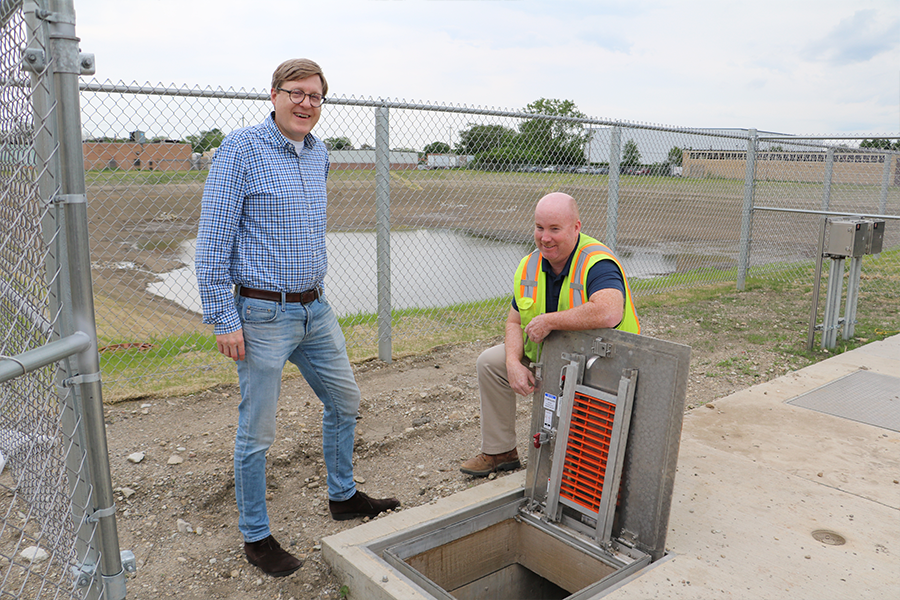
Like many engineering firms, Civiltech is structured in departments that align with the various engineering services and disciplines we provide. However, at Civiltech the work within those departments does not function in silos. Civiltech offers a dynamic collaborative approach to our projects ensuring that our clients receive the full benefit of our staff’s collective knowledge, expertise, and skill. Our firm has a robust knowledge management program with a unique “working out loud” approach to project based communications and industry expertise.
One of the most common cross-discipline collaborations at Civiltech is when Phase I and Phase II engineers work closely as separate but integrated teams. With tight collaboration, the full team is aware of key design decisions and project status. Fundamental design elements established in Phase I are seamlessly carried into Phase II. This type of overlap allows for expedited project schedules, approvals and a well-coordinated transition between phases.
Other common cross-discipline examples include Phase III staff providing construction expertise early in the design process to anticipate and minimize construction problems down the road. Some of our specialized services are often actively involved in a project through its entirety such as structural, drainage, and traffic signal engineering. Or, our Right of Way staff may provide expert analysis that assists the Phase I and Phase II teams in making strategic design decisions.
Sometimes, a project has unique parameters that engage and entwine the expertise of a different combination of disciplines. One example of this is the newly completed Berkeley Flood Control Project. About 10 years ago, Berkeley had begun experiencing an increase in urban flooding, including areas that had never flooded previously. Civiltech provided hydrologic and hydraulic model analysis to develop an improvement recommendation that involved adding new sections of relief storm sewer and a detention basin for additional storm water storage. The detention basin included a new pump station.
The cost of these critical improvements came with a big price tag. So as the team began to work on the Phase II plans and specifications, Civiltech’s Director of Water Resources, Tom Liliensiek, P.E., began helping the Village search for funding sources. Also, at this time, with the contract documents in progress, funding and financing being pursued, and the permitting process underway, Tom pulled in the Phase III Resident Engineer, Hugh Gilgunn, P.E. Hugh had a strong familiarity with the community, the infrastructure, and the site conditions from his role as R.E. on an adjacent Berkeley project. Hugh was able to review the plans, identify potential issues, and assist with utility coordination design issues leveraging his previous utility coordination effort.
The Civiltech team’s efforts to assist in procuring funding for the project was a success. The project received funding from Metropolitan Water Reclamation District (MWRD), through a Cook County Community Development Block Grant and from IDOT under the Economic Development Program (EDP). But with this substantial funding came new challenges for Phase III. Each funding source had unique conditions including stipulations regarding the subcontracting companies used and special documentation requirements. To assist Hugh as the project R.E., Tom remained active on the project. Hugh and Tom met with MWRD to ensure that they had a clear understanding of the processes and requirements. Tom helped guide Hugh and the general contractor through the paperwork.
 In addition to the atypical requirements placed on the contractor from the funding sources, the design of the storm water pump station created additional challenges. The pump station involved four additional and unique subcontractors with specialized work to be coordinated, as well as a complex set of specifications. Tom remained on the project to assist in the coordination of long lead time equipment, to assist Hugh with the technical requirements of the pump station, and to offer value engineering solutions. Tom also provided responsive design solutions when Hugh discovered constructability issues.
In addition to the atypical requirements placed on the contractor from the funding sources, the design of the storm water pump station created additional challenges. The pump station involved four additional and unique subcontractors with specialized work to be coordinated, as well as a complex set of specifications. Tom remained on the project to assist in the coordination of long lead time equipment, to assist Hugh with the technical requirements of the pump station, and to offer value engineering solutions. Tom also provided responsive design solutions when Hugh discovered constructability issues.
In addition to assisting with the requirements of the funding sources and with the coordination and construction of the pump station, Tom had a personal interest in being active on the project through its completion having been involved since its conception. By working closely together across departments, Tom and Hugh ensured that the project was completed successfully and that the Village secured all of its grant money.
